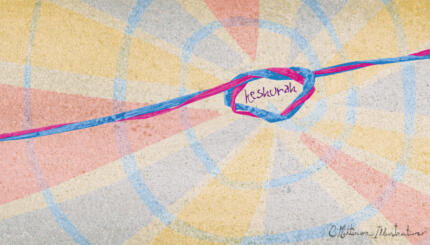Commentary on Parashat Vaetchanan, Deuteronomy 3:23-7:11
As the Israelites are poised to enter Canaan in Parshat Vaetchanan, Moses finally finds his tongue and speaks at length with his people, instructing them on his legacy. Central to Moses’ oration is the insistence that the events of his life have unfurled before the people’s “own eyes.”
As Moses retells it, his audience’s presence was essential to the covenant at Sinai: “The Lord your God sealed a covenant with us at Horeb. Not with our ancestors did the Lord seal this covenant but with us — we who are here today, all of us alive.” And with reference to the miracles of the Exodus, Moses declaims: “You yourself were shown to know that the Lord is God[.]” (Deuteronomy 4:3; 5:3; 4:35).
Moses’ insistence, however, is more fiction than fact. For the most part, his audience was not present at Sinai or the Exodus. The generation to which he speaks was born in the desert, to parents now buried beneath its sands. And it was those parents who saw the revelation at Sinai, who trod the dry depths of the split sea.
This peculiar misidentification — what commentator Robert Alter calls a “slide of identification between one generation and another” — cannot be understood as the slip of an old, addled mind. Instead, I would proffer that this “slide” is an exceptionally powerful means of laying the experiential foundation for the Torah’s core injunction against oppression of the stranger.
With your help, My Jewish Learning can provide endless opportunities for learning, connection and discovery.
But We Weren’t There!
Mentioned no fewer than 36 times throughout Scripture, the Torah’s exhortations on the treatment of the stranger often appear with a companion explanation: Heed the stranger’s treatment because “you know the feelings of a stranger, for you were strangers in the land of Egypt” (Exodus 23:9). But this explanation, like Moses’ feint, is premised on a sleight-of-hand. Our forebears were enslaved in Egypt, but we–their far-distant progeny–were not.
Moses’ generational slide begs to be interpreted less as a faithful description of historical fact and more as a normative charge to the nation. Through the frisson of misidentification, the desert generation — and we, Moses’ further-future audience — are implored to reach past the boundaries of self and become the witnesses whom the great leader invokes. We are goaded into taking on the existential reality of our enslaved ancestors.
Moses has set us up well. With this shrewd rhetorical strategy, he has urged us to harness the imaginative effort that empathy requires, training us in the mechanism for satisfying the Torah’s exhortations on the stranger. Just as we have transported ourselves past time’s boundaries to inhabit our enslaved ancestors, so too can we transport ourselves past the boundaries of ethnicity, nation, means and tongue that separate us from the contemporary stranger. The “slide of identification” can thus be understood as a practice-run, through which Moses’ audience limbers up to the imaginative exertions that our duties to the stranger demand.
Becoming Empathetic
But it is not only empathy’s mechanism of imaginative engagement that is revealed in Moses’ generational elision. The elision further helps us understand that empathy is work, that there is something awkward and uncomfortable about its habit. We must be schooled in its compulsory nature no less than 36 times, tutored in its essentialness through the heuristic of self-deception: “It was you who were a slave; it is you who knows the heart of a stranger.” Moses’ elision thus helps us internalize that empathy is not always and already there, burrowed inside like a jack-in-the-box, awaiting an opening to spring forth. It is rather an iterative effort that demands rehearsal and repetition.
And so too with us, modern Jews in a global world, who may take up the fight against the oppression of the world’s strangers–in lands not our own, on behalf of people facing trials so alien from ours; we cannot rely on an axiomatic claim that we understand the stranger’s plight because we, too, were strangers in Egypt. We know this claim to be untrue; or at least, we know that this claim reflects a truth in need of tending.
How then do we maintain the psychological muscle that Moses’ generational slide helped to build? How do we stave off its atrophy?
We can take a cue from Moses, who at the end of his life finally speaks freely to his people, telling them “their” story through his own and those of their forebears. To engage the empathic muscle, we too should immerse ourselves in stories. We should seek out the tales of the oppressed stranger, read her literature, ferret out her testimony. We should find ways to see her face when she speaks–through film, through lectures, through travel. We should train ourselves to pick out those igniting details from dry reports of facts, figures, troop movements, and aid shipments.
And when that empathic muscle is flexed, our imaginations gripped, we should charge ourselves with the knowledge that for Moses we will never — and should never — cease being the strangers of his story.
Provided by special arrangement with American Jewish World Service. To learn more, visit www.ajws.org.


